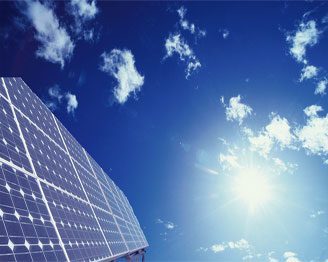Biomimicry of heliotropic plants – more efficient solar panels
 Many plants are heliotropic, gradually tilting towards the sun to optimize solar energy capture. Current sun-tracking solar panels involve the use of motors and electronic control systems, but we believe a biomimetic heliotropic solar panel can be created with the use of alternative materials and designs. Practically, the heliotropic solar panel could be useful in developing areas, where motor-based sun-tracking panels are not affordable. From an expressive standpoint, a solar panel that tilts towards the sun (like a sunflower) can help the public see a connection between the natural and the high tech. Solar cells that track the angle of the sun can be 38 percent more efficient at generating power than those that are mounted in a fixed position.
Many plants are heliotropic, gradually tilting towards the sun to optimize solar energy capture. Current sun-tracking solar panels involve the use of motors and electronic control systems, but we believe a biomimetic heliotropic solar panel can be created with the use of alternative materials and designs. Practically, the heliotropic solar panel could be useful in developing areas, where motor-based sun-tracking panels are not affordable. From an expressive standpoint, a solar panel that tilts towards the sun (like a sunflower) can help the public see a connection between the natural and the high tech. Solar cells that track the angle of the sun can be 38 percent more efficient at generating power than those that are mounted in a fixed position.
A team of three MIT students (Forrest Liau, Vyom Sharma, and George Whitfield) designed such a system. Their team, called Heliotrope, won top honors and a check for $10,000 in the finals of a competition aimed at developing innovative energy technologies.
They designed the system that imitates the way plants track the sun across the sky, by using the difference in temperature between shaded and sunny areas to change the properties of the material supporting solar photovoltaic cells. Unlike the systems which are currently being used the biomimetic system, once built, is completely passive, requiring no power source or electronics to control the movement. The team explored several different variations of the proposed system, using various materials including polymers and bimetallic strips. The system that shows the most promise, they said, mounts solar panels at the top of a curved arch made of a pair of metals such as aluminum and steel, which should be durable enough to withstand the elements with little or no maintenance.
They demonstrated a scale model of the arch by shining a spotlight to warm up one side and cause the arch to bend, tilting the solar panel toward the light. They explained that the prototypes are cheaper than existing systems for tracking the sun and could be built from materials that are readily available in developing nations.
MIT researchers have hit upon a simple, inexpensive, highly efficient process regarding storage of the solar energy. Until now, solar power has been a daytime-only energy source, because storing extra solar energy for later use is prohibitively expensive and grossly inefficient.
Inspired by the photosynthesis performed by plants, the researchers developed an unprecedented process that will allow the sun’s energy to be used to split water into hydrogen and oxygen gases. Later, the oxygen and hydrogen may be recombined inside a fuel cell, creating carbon-free electricity to power your house or your electric car, day or night.
The new technique takes advantage of a cobalt catalyst’s ability to create oxygen gas when combined with water and an electric current. The solar panels provide the electric current, and the energy from that current is stored in the form of the hydrogen and oxygen, rather than in a capacitor.
More engineering work needs to be done to integrate the new scientific discovery into existing photovoltaic systems, but they are very confident that such systems will become a reality. In fact, the MIT researchers hope that within 10 years, homeowners will be able to power their homes in daylight through photovoltaic cells, while using excess solar energy to produce hydrogen and oxygen to power their own household fuel cell.
Thou many systems which produce power for households already exist, these 2 concepts will help by increasing the efficiency of the systems as well as the cost reductions. It’s only a matter of time when all of the world countries step up and allow households to generate power for themselves and the electricity-by-wire from a central source could be a thing of the past.










The main drawback of Solar PV Systems is tracking the Sun. Much of energy produced by solar is last in providing power to the tracking system. The wonderful research by MIT students (Forrest Liau, Vyom Sharma, and George Whitfield) will help to solve the problem by adopting the motion of SUNFLOWER.
Many plants are phototropic/heliotropic, gradually tilting towards the sun to optimize solar energy capture. Practically, the heliotropic solar panel could be useful in developing areas, where motor-based sun-tracking panels are not affordable. From an expressive standpoint, a solar panel that tilts towards the sun (like a sunflower) can help the public see a connection between the natural and the high tech.
I heartily congratulate the MIT Students for their wide vision of adopting from nature to solve a complex problem in a simple way.
Dr.A.Jagadeesh Nellore (AP), India
Heliotropic flowers track the sun’s motion across the sky from East to West. During the night, the flowers may assume a random orientation, while at dawn they turn again towards the East where the sun rises. The motion is performed by motor cells in a flexible segment just below the flower, called a pulvinus. The motor cells are specialized in pumping potassium ions into nearby tissues, changing their turgor pressure. The segment flexes because the motor cells at the shadow side elongate due to a turgor rise. Heliotropism is a response to blue light.
Some solar tracking plants are not purely heliotropic: in those plants the change of orientation is an innate circadian motion triggered by light, which continues for one or more periods if the light cycle is interrupted.
Leaf heliotropism is the solar tracking behavior of plant leaves. Some plant species have leaves that orient themselves perpendicularly to the sun’s rays in the morning (diaheliotropism), and others have those that orient themselves parallel to these rays at midday (paraheliotropism). Floral heliotropism is not necessarily exhibited by the same plants that exhibit leaf heliotropism.
The research by MIT Scientists to adopt the peculiar nature of some plants to tracking system of Solar panels is indeed a major breakthrough.
Dr.A.Jagadeesh Nellore(AP),India
I wonder why these systems aren’t a default option when buildings and solar power plants are being built.
me pregunto por q n dan la respuesta q shop necesito!!!!!!!!
This depends on your latitude and where you are. If you’re in the northern hemisphere, it faces south, with a tilt direction at the sun with respect to the average tilt of the earth. If you’re in the southern hemisphere, the solar panels (both photovoltaic and solar thermal) face north. If you’re on the equator, then they may lay flat on your roof. In US at a latitude of 40 degrees, you may want a tilt of about 20 degrees (because of change of seasons). You can always angle the panels easier than modifying an existing roof. Be sure NOT to shade any part of photovoltaic panels at any time.
Can’t see a significant benefit from this technology…
The main advantage to me is the absence of maintenance. I don’t want to have to get on my roof when I’m70 years old to fix my heliostat.